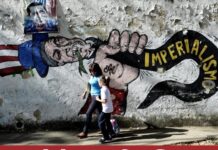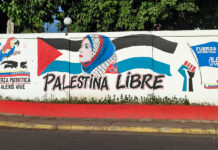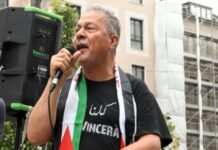
On the international and Palestinian day for the retrieval and liberation of the bodies of the martyrs, the Dismantle Damon campaign highlighted the 9 women martyrs — among the 552 Palestinian martyrs in total — whose bodies are held captive by the Zionist occupation regime in morgues and “numbers cemeteries,” where Palestinians and Arabs are buried with only a number and without their names.

Today, there are 552 known Palestinian martyrs held in the morgues and “numbers cemeteries,” including 256 in “numbers cemeteries” and 296 imprisoned in morgues and refrigerators since the re-implementation of the policy of imprisoning bodies in 2015. Among them are 9 female martyrs, 32 martyrs from the prisoners’ movement, 55 children under the age of 18, 5 martyrs from the 1948 occupied territories, and 6 martyrs from Palestinian refugees in Lebanon.

However, these numbers do not convey the full extent of the crime; multiple released detainees from Gaza held at the Sde Teiman torture camp, where extreme physical torture, sexual abuse and assault, murder, starvation and abuse of all forms have been routinely used against masses of Palestinians from Gaza abducted by the invading genocidal army, have testified to the presence of over 1,500 bodies of martyrs held there; the occupation regime has returned around 428 martyrs’ bodies en masse.

The nine women martyrs whose bodies are being held by the Zionist regime include a woman, Bayan Mohammed Jumaa Salama Eid, targeted just one month ago in an assassination attack in Tulkarem, a 17-year old girl, Asmaa Daraghmeh, as well as some of the most well-known women of the Palestinian resistance across generations, Dalal al-Mughrabi, Wafa Idriss, Dareen Abu Eisheh and Hanadi Jaradat.

These are the stories of the imprisoned women martyrs whose bodies are detained by the Zionist regime, with the full support, funding, and partnership of the United States and its fellow imperialist partners in Germany, Britain, France, Canada, Australia and elsewhere.
Bayan Mohammed Jumaa Salama Eid was martyred in Tulkarem refugee camp on 23 July 2024, when Zionist forces invaded and attacked the camp for 16 hours. They bombed a home in the camp with a drone airstrike, killing five Palestinians, including 22-year-old Bayan and her mother, 50-year-old Iman Mohammed Jumaa, and three prominent leaders of the Palestinian resistance in the camp, Ashraf Eid Zaher Nafeh, a leader of the Izz al-Din al-Qassam Brigades in Tulkarem camp, and Mohammed Ibrahim Awad and Mohammed Badie, leaders of the Al-Aqsa Martyrs’ Brigades in the camp. The occupation forces invaded the refugee camp — whose residents have been denied their right to return home to Palestine for over 76 years — with 25 military vehicles, then abducted the martyred bodies of Bayan, Ashraf Nafeh, Mohammed Awad and Mohammed Badie, after they attacked the camp with bulldozers, destroying neighbourhoods and tearing up electricity poles.

Maimouna Abdul Hamid Harasheh from the village of Bani Naim, east of al-Khalil, was martyred on 24 April 2024 when “Israeli” occupation forces shot her in the head at a checkpoint in occupied al-Khalil. Maimouna, 20, a university student with an exam scheduled later that day, was shot dead at the Beit Anun checkpoint, referred to as the “checkpoint of death.” Occupation forces deliberately left her to bleed to death and denied access to ambulance crews seeking to provide her with medical attention before they kidnapped her body, where they now hold her body hostage in their morgue.
Labiba Faze’ Sawafta was martyred on 21 April 2024 when “Israeli” Occupation forces opened fire on her at the Hamra checkpoint in the northern occupied Jordan Valley, in Palestine’s West Bank. Occupation forces claimed that Labiba, 43, from Tubas, wanted to carry out a stabbing operation in retaliation for the ongoing genocide in Gaza. After they shot her in cold blood, once again, as in Maimouna’s case, the occupation forces denied access to ambulance crews, instead kidnapping her body.

Asmaa Imad Daraghmeh was martyred on 8 April 2024 when she was shot dead by the “Israeli” Occupation Forces at the Tayasir checkpoint east of Tubas in the northern West Bank of occupied Palestine. Asmaa, a 17-year-old girl, was shot at a distance of 10 meters (33 feet) away, when the heavily armed soldiers claimed that they were at mortal threat from a knife Asmaa held. As in the cases of Labiba and Maimouna, once again the occupation forces blocked access to a Palestinian Red Crescent Society ambulance, forcing the teen girl to bleed out without receiving medical care, and instead kidnapped her body.
Wafa Abdul Rahman Baradei was martyred on 19 May 2021 when she was shot dead by an illegal Zionist settler near the so-called “Kiryat Arba” settlement. The settlers claimed that Wafa, 34, from al-Hallajil area near the village of Bani Naim in the Al-Khalil district, was carrying a gun and intended to carry out a resistance operation at the settlement. After the settlers murdered Wafa, occupation forces invaded her village and ransacked her home in the late night hours, as they stole her body and have held it hostage for over three years.

Hanadi Tayseer Jaradat was martyred on 4 October 2003 in a martyrdom operation she carried out in the Maxim restaurant in Haifa, occupied Palestine. Hanadi, 28, was a law student who was scheduled to qualify as a lawyer in the coming weeks, following the completion of her study at Yarmouk University in Jordan. Hanadi was a member of the Palestinian Islamic Jihad Movement, as was her younger brother, Fadi, and her cousin, Salah, both of whom were martyred after being assassinated by an undercover Zionist infiltrator in Jenin. In 2012, Hanadi Jaradat was honoured by the Arab Lawyers Union for her commitment and sacrifice for Palestine. “By the power and determination of God, I decided to be the sixth female martyr who will make her body into shrapnel that explodes to kill the Zionists and destroy every settler and Zionist. And because we are not the only ones who must continue to pay the price and reap the reward for their crimes, and so that our mothers do not continue to pay the price for the Zionist crimes…” she said before embarking on her operation. The occupation forces collected Hanadi’s remains and buried her in the “numbers cemeteries,” alongside Dareen Abu Eisheh and Wafaa Idriss.
Dareen Abu Eisheh was martyred on 27 February 2002 when she decided to become the second woman to carry out a martyrdom operation as part of the Al-Aqsa Intifada. Dareen, 22, was a student at An-Najah National University and an ardent activist with the Islamic Bloc, where she studied English language and literature. She was deeply religious and very politically active, described as the first to attend rallies and demonstrations. Dedicated to Hamas, the Islamic Resistance Movement, Dareen first approached the movement to join the al-Qassam Brigades and carry out an operation, but was denied because, at that time, the movement’s interpretation was that the struggle was the task of men, unless there were no men to carry out the fight. However, she was committed to participate directly through carrying out an operation, and then approached the Al-Aqsa Martyrs Brigades of Fateh, who agreed to arm her to carry out a bombing at the Maccabim checkpoint between Jerusalem and Tel Aviv. She wore the banner of the Al-Aqsa Martyrs’ Brigades, layered over with a green banner for the Al-Qassam Brigades that she made, in the video she recorded, declaring: “I wanted to be the second woman to carry out a martyrdom operation and take revenge for the blood of the martyrs and the destruction of the sanctity of al-Aqsa mosque.” After her martyrdom, she was known as the “daughter of all factions,” with Fateh, Hamas and Islamic Jihad coming together to jointly claim her, while the occupation held her remains, burying her in the “numbers cemetery” where she has remained for 21 years.

Wafaa Idriss was martyred on 21 January 2002 in the first martyrdom operation carried out by a Palestinian woman against the Zionist occupation. A longtime Fateh activist, Wafaa, 28, was a Palestinian refugee who was born and raised in al-Ama’ri refugee camp in Ramallah. During the first intifada, she joined the camp’s women’s committee, providing social support, engaging in food distribution and supported prisoners’ families. She trained as a medic and volunteered with the Palestinian Red Crescent Society. She went to the Al-Aqsa Martyrs’ Brigades, Fateh’s armed wing, when she decided to carry out an operation in the middle of Tel Aviv. Her remains were confiscated and buried in the “cemetery of numbers” by the Zionist regime, but a mass memorial held for her in Ramallah in January 2002 drew thousands of women, as a Fateh women’s leader said, “Nobody can prevent the women from taking part in this war toward liberating Palestine,” and attendees chanted: “Women standing beside men, hand in hand, will march toward Jerusalem.”

Dalal al Mughrabi is an icon of the Palestinian resistance movement and one of the most widely-known women Palestinian fighters. A Palestinian refugee born in Sabra refugee camp in Lebanon to her Palestinian father, forced from his home in occupied Yafa during the Nakba, and her Lebanese mother, Dalal was trained as a nurse and joined Fateh and the Palestinian liberation movement in 1975, at the age of 16, at the beginning of the Lebanese civil war. She became a lieutenant in Fateh’s armed organization and was offered a political post in Italy, but declined in order to remain part of the armed struggle. She led a group of 11 Palestinian and Lebanese fighters in a boat to enter occupied Palestine via the beach near occupied Yafa, seeking to attack the Zionist war ministry or to reach the Knesset for a military operation to demand the release of Palestinian prisoners. The group seized a bus, holding the inhabitants captive, before Zionist forces stopped the bus. During a shooting battle between the resistance fighters and the occupation soldiers, Dalal raised the Palestinian flag and declared a Palestinian state. In a manner reminiscent of the “Hannibal doctrine” vividly illustrated by the IOF’s mass attacks on 7 October to prevent Zionists from being taken captive by the resistance, occupation forces bombed the bus from a helicopter gunship, exploding it, killing 38 of those held captive and 9 of the resistance fighters. Dalal al-Mughrabi’s body was supposed to be returned in 2008 to her family in Lebanon as part of the prisoner exchange achieved by Hezbollah, but the Zionist regime dubiously claimed they could not “locate her body” in the numbers cemetery, sending a coffin containing stones to her family.
After her martyrdom, Dalal al Mughrabi has become an icon of Palestinian resistance. Palestinian institutions inside and outside Palestine are named after her — and Palestinian organizations have been routinely pressured by the United States and various European Union countries, including Norway and Denmark, to remove her name from these women’s centers and fellow institutions, in an attempt to erase the legacy of resistance, liberation and commitment to struggle that she represents.
These are the stories of just nine of the Palestinian martyrs, the Palestinian women whose bodies are held captive by the occupation, even as they remain immortal in the hearts and minds of the Palestinian people and all who care for justice and liberation. The Zionist regime has been unable to erase their legacy of struggle, the meaning of their names, and their love for Palestine by holding their bodies hostage.
We call upon Palestinian and Arab networks, solidarity groups supporting the prisoners’ struggle and boycott campaigns around the world to join in the international campaign to recover and release the remains of Palestinian martyrs, and to expand the support and solidarity for Palestinian prisoners and martyrs everywhere around the world, for their liberation and the liberation of Palestine from the river to the sea. Specifically, we urge women’s organizations and feminist movements to take up the campaign for the liberation of Palestinian women prisoners and of the imprisoned martyrs’ bodies, for the liberation of their people and their homeland.
It is critical that we take action on an international level to popularize the campaign to liberate the bodies of the martyrs. This is part and parcel of the struggle for the dignity and lives of the Palestinian people — and of humanity — being led by the Palestinian armed resistance confronting the genocidal Zionist regime and its imperialist partners in the United States, Germany, France, Britain, Canada and fellow imperialist powers.
Discover more from Samidoun: Palestinian Prisoner Solidarity Network
Subscribe to get the latest posts sent to your email.




